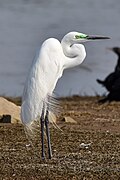Great egret
The great egret (Ardea alba) (also known an the common egret, large egret, great white egret, or great white heron) is a large wading bird found worldwide.
| Great egret | |
|---|---|

| |
| Great egret | |
| Conservation status | |
| Scientific classification | |
| Kingdom: | |
| Class: | |
| Order: | |
| Family: | |
| Genus: | |
| Binomial name | |
| Ardea alba | |
It is the second-largest member of the heron family in America (second only to the great blue heron). It lives in mudflats, tidal shallows marshes, lakes, rivers and flooded paddy fields. It winters in the south down to Colombia. The great egret flies with slow wing beats and has a deep, croaking call. It is 90-102 cm long.
Diet
The great egret eats fish, lizards, frogs, crayfish, small rodents, and insects. It often hunts in shallow water, usually impaling the prey on its long, sharp bill.
Egg and nests
The great egret's nest is a platform of twigs and sticks that is built in trees or on the ground. Females lay 3-5 pale blue-green eggs in each clutch (a set of eggs laid at one time). The incubation period of the eggs is 23–26 days.
References
Birds of the Indian Subcontinent-2010, Oxford University Press, Richard Grimmett, Carol Inskipp, Tim Inskipp
Great Egret Media
Sharing space on a log with a grey heron (Ardea cinerea), Oriental darter (Anhinga melanogaster) and a group of little cormorants (Microcarbo niger)
Non-breeding adult wading near a Mugger crocodile
Egg in the collection of Museum Wiesbaden
Landing in Matadero Creek
Great Egret capturing and swallowing a fish (partially slowed video).
A great egret in the Yolo Bypass Wildlife Area









